Zoom
Trash

404. When Steve Jobs refused to allow Flash on iOS devices, he argued that HTML5 could do everything Flash did. He wasn't being entirely honest - the reality distortion field was strong that day - but ultimately Apple won and Adobe didn't; HTML5, not Flash, is the technology that's transforming the web. 28 HTML5 Features, Tips, and Techniques you Must Know. Introduction to HTML 5. Quick Tip: HTML5 Features you Should be Using Right Now. Learning to Love HTML5. Advertisement It seems that new resources and articles for teaching and promoting HTML5 are popping up almost daily.

We’ve been given HTML5 templates in the form of the HTML5 boilerplate1 and HTML5 Reset2 (although they both go beyond just HTML5 stuff). We’ve got a plethora of books3 to choose from that cover HTML5 and its related technologies. We’ve got shivs4, galleries5, and a physician6 to help heal your HTML5 maladies. And don’t forget the official spec7. From my own vantage point — aside from a few disputes8 about what the term “HTML5″ should and shouldn’t mean — the web design and development community has for the most part embraced all the new technologies and semantics with a positive attitude. Flickr Photo by Jeremy Keith9 While it’s certainly true that HTML5 has the potential to change the web for the better, the reality is that these kinds of major changes can be difficult to grasp and embrace.
HTML5: The Basics (1 of 4) The next iteration of HTML has been met with excitement by some, loathing by others and confusion/fear by everyone else.
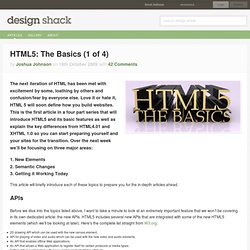
Love it or hate it, HTML 5 will soon define how you build websites. This is the first article in a four part series that will introduce HTML5 and its basic features as well as explain the key differences from HTML4.01 and XHTML 1.0 so you can start preparing yourself and your sites for the transition. Over the next week we’ll be focusing on three major areas: 1. New Elements 2. This article will briefly introduce each of these topics to prepare you for the in-depth articles ahead. APIs Before we dive into the topics listed above, I want to take a minute to look at an extremely important feature that we won’t be covering in its own dedicated article: the new APIs.
As you can see, the principal purpose of these APIs is to facilitate web application creation. Preparing for HTML5 with Semantic Class Names. Some time ago I was asked in an interview whether I preferred HTML or CSS.
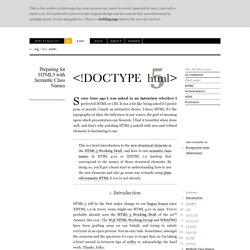
It was a bit like being asked if I prefer pens or pencils. I made an instinctive choice. I chose HTML. It’s the typography of data; the inflection in our voices; the grid of meaning upon which presentation can flourish. HTML5 Tutorial. HTML5 for Beginners. Use it now, its easy! Ok, so there are a lot of articles out there on HTML5, especially since Google Wave arrived (because it’s the first major app to run on the language), but all the information that you need to know in order to start using it now is either too complicated, or spread out over various websites / articles / tutorials.
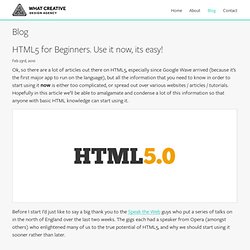
Hopefully in this article we’ll be able to amalgamate and condense a lot of this information so that anyone with basic HTML knowledge can start using it. Before I start I’d just like to say a big thank you to the Speak the Web guys who put a series of talks on in the north of England over the last two weeks. The gigs each had a speaker from Opera (amongst others) who enlightened many of us to the true potential of HTML5, and why we should start using it sooner rather than later.
As I’m sure you probably already know, Internet Explorer does not support HTML5. Surprise, surprise. 1. Unfortunately this is unavoidable if you want to use HTML5 across all major browsers. 2. 3. 4. 5. HTML5 Rocks My Socks Off. HTML5 and CSS3 are now able to be used in most modern browsers.
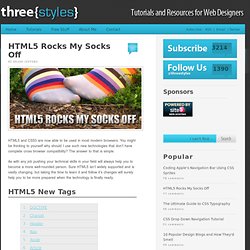
You might be thinking to yourself why should I use such new technologies that don’t have complete cross browser compatibility? The answer to that is simple. As with any job pushing your technical skills in your field will always help you to become a more well-rounded person. Sure HTML5 isn’t widely supported and is vastly changing, but taking the time to learn it and follow it’s changes will surely help you to be more prepared when the technology is finally ready. The beautiful part about the new way to declare a DOCTYPE is that it’s so simple.
This is a simplified version of the charset property which also helps you to memorize this bit of code. The new header element was created to contain the introductory information of your site. A header element is intended to usually contain the section’s heading (an h1–h6 element or an hgroup element), but this is not required. The new ASIDE element is a bit confusing. Simple Website Layout Tutorial Using HTML 5 and CSS 3. Simple Website Layout Tutorial Using HTML 5 and CSS 3 As most of us know HTML 5 has created a big buzz on internet and is sure to give Adobe a hard time.

Apple believes that HTML5 is what will define the web and would love to see more developers adopt it instead of Flash. Now that big video sites such as YouTube are testing support for HTML5 (Mashable). HTML 5 is a breakthrough which will improve the sites from design view point, seo etc. It when combined with css3 can make amazing web sites. The Most prominent additions in HTML 5 are tags like <header>, <footer>, <aside>, <nav>, <audio> etc. <header> = Header (Head area of the site)<nav> = Navigation (Menu/Navigation Area)<footer> = Footer Area<aside> = An area on a side (Side Bar)
Design & Code a Cool iPhone App Website in HTML5. HTML5 is definitely the flavor of the month, with everyone in the design community getting excited about its release.
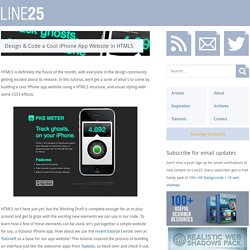
In this tutorial, we’ll get a taste of what’s to come by building a cool iPhone app website using a HTML5 structure, and visual styling with some CSS3 effects. HTML5 isn’t here just yet, but the Working Draft is complete enough for us to play around and get to grips with the exciting new elements we can use in our code. To learn how a few of these elements can be used, let’s put together a simple website for say, a fictional iPhone app.
How about we use the recent tutorial I wrote over at Tutorial9 as a base for our app website? This tutorial covered the process of building an interface just like the awesome apps from Tapbots, so head over and check it out, then we’ll be ready to build an accompanying website for our PKE Meter application. View the demo First, we’ll need to put together a concept for our app website. Fill out the design with a description of the app. HTML 5 and CSS 3: The Techniques You’ll Soon Be Using. In this tutorial, we are going to build a blog page using next-generation techniques from HTML 5 and CSS 3.
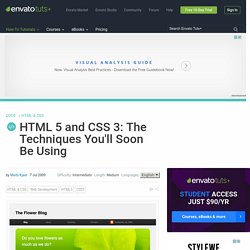
The tutorial aims to demonstrate how we will be building websites when the specifications are finalized and the browser vendors have implemented them. If you already know HTML and CSS, it should be easy to follow along. Coding An HTML 5 Layout From Scratch. HTML5 and CSS3 have just arrived (kinda), and with them a whole new battle for the ‘best markup’ trophy has begun.
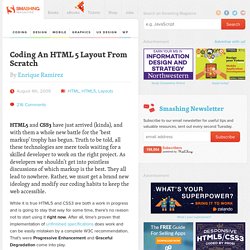
Truth to be told, all these technologies are mere tools waiting for a skilled developer to work on the right project. As developers we shouldn’t get into pointless discussions of which markup is the best. They all lead to nowhere. Rather, we must get a brand new ideology and modify our coding habits to keep the web accessible.